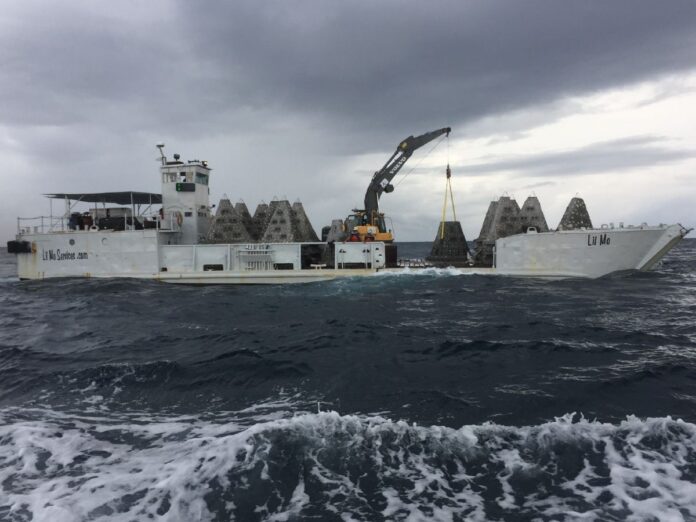SOUTH PADRE ISLAND — The RGV Reef project, aimed at vastly increasing the population of red snapper and other game fish off the coast of South Texas, took a step forward June 27 with the deployment of 50, three-ton concrete pyramids to build up the high-relief portion of the artificial reef.
The project is the brainchild of the grass-roots group Friends of RGV Reef, and has attracted marine scientists studying the results of reefing on snapper populations.
The pyramids, each 8 to 10 feet tall, were transported and sunk by the 115-foot, Vietnam-era landing craft Lil’ Mo, owned by Lil’ Mo Marine Services, which donated its time and the pyramids. The structures, made by Atlantis Marine Habitats LLC, feature cavities that provide shelter for adult snapper.
“Friends” president Gary Glick said 42 of the pyramids were placed in groups of four to form a “trolling trail,” while cinderblocks will be sunk around some of the pyramids and limestone rip-rap around others to determine which is more effective at boosting snapper productivity.
Eight of the pyramids were placed at the corners of a section of seafloor where low-relief juvenile snapper “survival modules” have been placed, Glick said. The modules are slabs of concrete embedded with shells and rocks to provide shelter for the fish.
The pyramids’ cavities house data-loggers that record signals from sonic-pinging tags placed in fish stomachs by a team of marine biologists studying the data for clues to predation behavior, Glick said. Triangulation of the signals via the multiple data-loggers allows them to pinpoint where the juveniles are most likely to get eaten by larger fish.
The seafloor off the South Texas coast is naturally featureless, providing little shelter for young snapper to avoid predators, which substantially reduces the population of snapper and other game fish.
The ultimate goal of “Friends” is 1,650 acres of artificial reef composed of high-relief objects, like pyramids, combined with low- and medium-relief aspects necessary to protect fish during all stages of development leading up to adulthood. A derelict shrimp boat and tugboat sunk at the site last November are examples of ultra-high-relief reef, Glick said.
RGV Reef is located roughly 14 nautical miles north of the Brazos Santiago Pass jetties and eight nautical miles off South Padre Island.
Lil’ Mo also will donate its services for the next step: sinking 63,000 cinderblocks over 173 acres at the site for a snapper nursery. Glick characterized the company’s contributions to the project as “astounding.”
“Atlantis and Lil’ Mo like us,” he said. “They think that we are the future of artificial reefing, which is their primary business.”
Glick said Lil’ Mo has sunk about 6,000 Atlantis-built pyramids for the Texas Parks and Wildlife Department, and other entities such as the Coastal Conservation Association, which also helped fund the RGV Reef project. Scientists estimate that the cinderblocks alone will mean another 60,000 to 250,000 snapper making it to adulthood, he said.
“We talk about snapper because that’s where all the research is, and it’s all snapper in the scientific literature,” Glick said. “But we know that when we make things right for snapper, we make things right for all of the less-studied species.”
RGV Reef also will create habitat for fish like menhaden, or pogie, a forage fish for snapper and other popular game fish, including kingfish, bonito, ling, sailfish, tarpon and jackfish, he said. The scarcer the fish, the more hooks they encounter, the smarter they get and the harder to catch — especially for non-expert fishermen like a family on vacation, Glick said.
“The object of the game is to make enough fish that a family with kids can get out there and actually catch fish,” he said. “So what we want to do is we want dumb fish, and to have dumb fish you have to have a lot of fish.”
There’s still a long way to go, and it’s all a matter of funding, Glick said. Friends has 10,000 tons of donated concrete reef material at the Port of Brownsville ready to be sunk, for example, though hiring the barge the job requires is prohibitively expensive, he said.
“This first deployment doesn’t use up much of 1,650-acre reef, and we could really use more money to help build the reef,” Glick said. “But it’s an excellent start to growing dumb fish.”





